Humans make mistakes, and these mistakes can cause defective products.
Poka Yoke, also known as mistake-proofing, is a technique for avoiding simple human errors at work. The idea was originally developed in the 1960s by Shigeo Shingo who was one of the IE engineers at Toyota.
Poka Yoke’s are mechanisms used to eliminate errors by effectively making it impossible to make mistakes in a given process. And they can be used everywhere.
To give an example of Poka Yoke design – filing cabinets could fall over if too many drawers were pulled out at the same time. For some cabinets, opening one drawer now locks all the rest, reducing the chance of the cabinet tipping. Another example of Poka-Yoke device – many elevators are equipped with an electric eye to prevent doors from shutting on people. They are also equipped with sensors and alarms to prevent operation when overloaded.
Why Poka Yoke?
Manufacturing defective products can be very costly. Some customers will return a whole batch of parts if they find just one of them to be defective. And some products are manufactured for safety critical applications in motor vehicles, aerospace and oil exploration etc.
A failure in these areas can have very serious consequences and potentially cause loss of life.
So let’s see the relationship of defects and human errors.
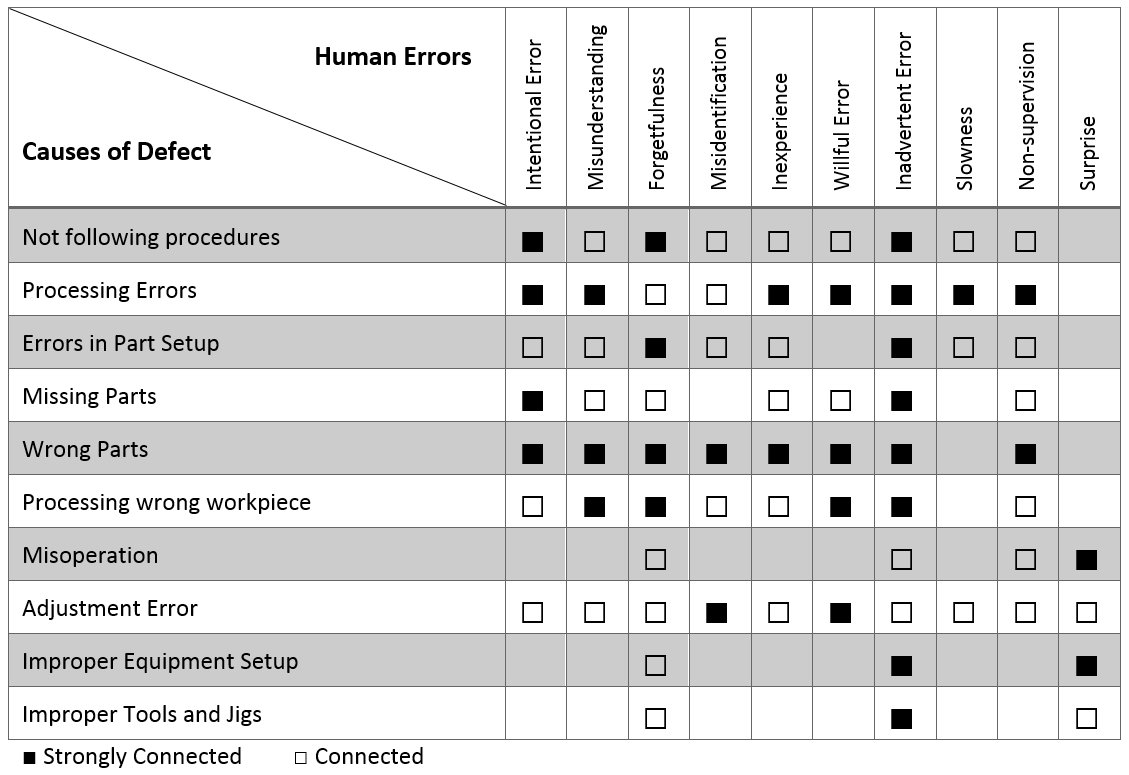
Human error should be nipped in the bud before they become bigger issues. Poka Yoke focuses on reducing or eliminating human errors, which cause defects.
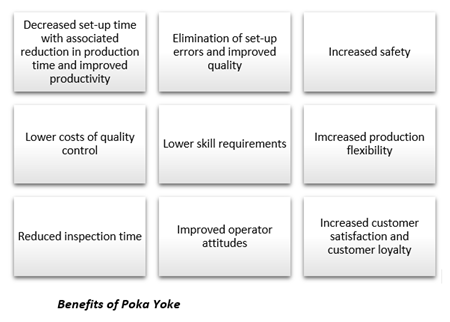 Principles of Mistake-proofing/Poka Yoke
Principles of Mistake-proofing/Poka Yoke
Mistake-proofing/Poka Yoke is based on 6 principles. Listed in order of preference in fundamentally addressing mistakes:
- Elimination (“don’t do it anymore”) is to eliminate the possibility of error by redesigning the product or process so that the task or part is no longer necessary.
- Prevention (“make sure it can never be done wrong”) is to design and engineer the product or process so that it is impossible to make a mistake at all.
- Replacement (“use something better”) is to substitute a more reliable process to improve consistency.
- Facilitation (“make tasks easier to perform”) is to employ techniques and to combine steps to make work easier to perform.
- Detection(“notice what is going wrong and stop it”) is to identify an error before further processing occurs so that the user can quickly correct the problem.
- Mitigation (“don’t let the situation get too bad”) is to seek to minimize the effects of errors.
Elimination, Prevention, Replacement and Facilitation are to avoid the occurrence of mistakes. Detection and Mitigation are to minimize the effects of mistakes once they occur.
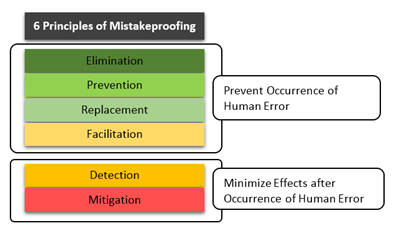 Prevention vs Detection
Prevention vs Detection
Ideally, Poka Yoke’s ensure the process is designed so that mistakes can be prevented before they occur; preventing defects from occurring in the first place. Where this is not possible, Poka Yokes perform a detective function, correcting and eliminating defects in the process as early as possible.
A Prevention-based Poka Yoke system acts before a defect occurs. The Poka Yoke mechanisms sense an abnormality that is about to happen and then signal the occurrence.
A Detection-based Poka Yoke signals the user when a mistake has been made. The system does not allow continuation of the process so that the user can quickly correct the problem.

In many situations it is not possible, or economically feasible to prevent defects, particularly where the capital cost of the Poka-Yoke mechanism, far exceeds the cost of prevention.
For these situations, defects are detected early in the process, preventing them from flowing into downstream processes.
There are two approaches for Poka Yoke devices:-
Control Approach: This approach senses a problem and stops a line or process so that corrective action can take place immediately, thus avoiding serial defect generation.
Warning Approach: This approach signals the occurrence of a deviation or trend of deviations through an escalating series of buzzers, lights or other warning devices. However, unlike the control method, the warning method does not shut down the process on every occurrence.
Poka Yoke devices consist of three effective methods to ensure detection and prevention of mistakes: 1.Contact method 2. Fixed-Value method 3. Motion-step method; Each method can be used in Control approach or Warning approach.
 Contact method detects any deviation in shapes, dimensions, forms, position or other physical characteristics through mechanisms that are kept in direct contact with the part. Contact method can be used in situations of rapid repetition, infrequent production or environmental problems such as poor lighting, critical temperature, dust, noise and so on.
Contact method detects any deviation in shapes, dimensions, forms, position or other physical characteristics through mechanisms that are kept in direct contact with the part. Contact method can be used in situations of rapid repetition, infrequent production or environmental problems such as poor lighting, critical temperature, dust, noise and so on.
Fixed value method is used in operations, where the same activities is repeated several times. The method employs automatic counters or optical devices and controls the number of moves, rate and length of movement as well as other critical operating parameters.
Motion step method is useful for processes requiring several different activities performed in sequence by a single operator. The method ensures that the operator dose not mistakenly perform a step that is not part of the normal process.
Commonly Implemented Poka Yoke Devices in Manufacturing
Good Poka Yoke devices should be simple and inexpensive. They need to be cost-effective towards the process. They should be integral part of the process, implementing what Shingo calls “100%” inspection. They should be placed close to where the mistakes occur, providing immediate feedback to the workers so that the mistakes can be corrected.
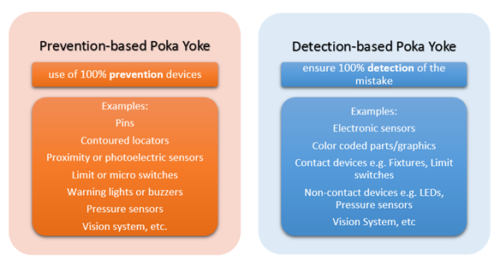 Examples of Poka Yoke Used in Manufacturing/Assembly Process (Projects by RNA Automation Ltd):
Examples of Poka Yoke Used in Manufacturing/Assembly Process (Projects by RNA Automation Ltd):
 |
Fuel Tank Poka Yoke Assembly with flash testing & leak testing
Poka Yoke is crucial to the assemblies and critically controlled within the whole production process. Mistake proofing techniques including Proximity sensors, custom designed fixtures, vision system, pins, pressure sensors, barcode reader, warning lights and dot marking are used to prevent errors committed by operators. They allow the mistake to be corrected and solved without delay. |
 |
Carpet Gap Hider Poka Yoke Station
|
 |
Robotic Clipping & Welding System
|
 |
Laser Drilling Process Cell
|
Above are just a few examples of Poka Yoke devices. There are many other types of devices that reduce human errors without requiring a heavy investment.
How to Implement
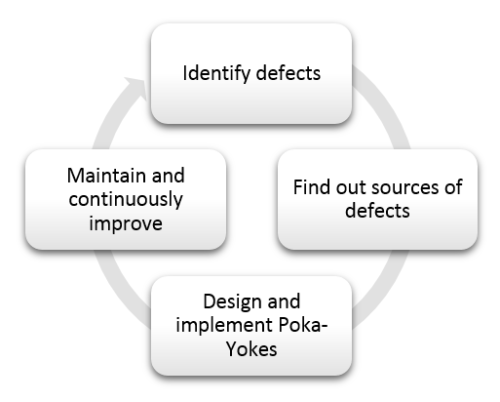 First, Get the right people together to discuss and review the product and the manufacturing and assembly process. Then identify and find out sources of defects. From the design perspective, review the features of the parts and how they are assembled. A simple change in product design may make a huge difference. Have Poka Yoke expert in these conversations, great ideas for improvement will come out due to their experience. Effectiveness of Poka Yoke technique should be reviewed continuously. Continue to maintain and improve the processes and measure the success.
First, Get the right people together to discuss and review the product and the manufacturing and assembly process. Then identify and find out sources of defects. From the design perspective, review the features of the parts and how they are assembled. A simple change in product design may make a huge difference. Have Poka Yoke expert in these conversations, great ideas for improvement will come out due to their experience. Effectiveness of Poka Yoke technique should be reviewed continuously. Continue to maintain and improve the processes and measure the success.
Poka Yoke is the fastest way to zero defects and acts as a key enabler for efficient manufacturing. Poka Yokes are a science and also an art. Searching for creative solutions to avoid or detect errors for close to zero investment is what invites innovation.
Written by Ying Zhang of RNA Automation Ltd
About the author:
![]() Ying Zhang
Ying Zhang
RNA Automation Ltd
Website: http://www.rnaautomation.com
Linkedin: Ying Zhang
Marketing Manager at RNA Automation, a leading automation supplier of parts handing and special purpose machines to a variety of industries. Ying has over 11 years of B2B marketing experience in the engineering and automation industry, and her passion lies in driving awareness on what automation solutions best serve manufacturers improving their productivity and success.
Editors Footnote:
I want to thank Ying and RNA Automation for reaching out to us and offering to post their article on The Automation Blog.
If you’ would like to join Ying as a guest blogger here on The Automation Blog, let me know using the contact form here.
Sincerely, Shawn Tierney of The Automation Blog.

Reference:
- “The Use of Poka Yoke with Medical Device Design and Manufacturing,” Jim Shore, Product and Process Improvement Leader, Dynisco, 17 May, 2011. mastercontrol.com.
- “Mistake Proofing/Error Proofing”, Retrieved from https://quality-one.com/mistake-proofing
- “Error Proofing and Poka Yoke Techniques”, Marc Smith, Error Proofing and Poka Yoke discussion threads in the Elsmar Cove Forums, 5 Auguest, 2004. elsmar.com
- Dhon G. Dungca. “Poka-Yoke”. Retrieved from https://slideplayer.com/slide/4471730/
- Ramzi Hammani. “Poka Yoke”, Introduction to Supply Chain Management. Retrieved from https://www.slideshare.net/Aditya…
- Anthony Inman. “Poka-Yoke”. Encyclopedia of Management. Retrieved from https://www.referenceforbusiness.com/management/Or-Pr/Poka-Yoke.html
- vigneshwari. “Total quality management”, Benchmarking and poka yoke. Retrieved from https://slideplayer.com/slide/12134070/
- Harry Robinson. “Using Poka-Yoke Techniques for Early Defect Detection”. Retrieved from https://pdfs.semanticscholar.org/6069…
- “Six Principles of Mistake Proofing, “ Tim McMahon, A Lean Jorney, 20 July, 2016. http://www.aleanjourney.com/2016/07/six-principles-of-mistake-proofing.html
- “Mistakeproofing the Design of Construction Process Using Inventive Problem Solving”, Final Report for CPWR Small Study No. 16-3-PS. Retrieved from http://www.elcosh.org/document/4306…
- “A Strategy for Performance Excellence”. Retrieved from https://slideplayer.com/slide/6998/
Discover more from The Automation Blog
Subscribe to get the latest posts sent to your email.





